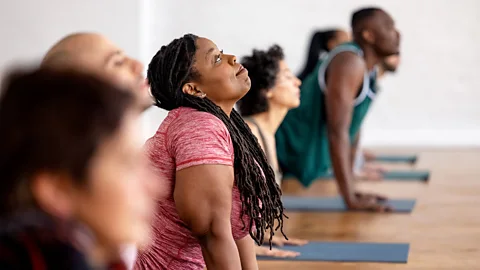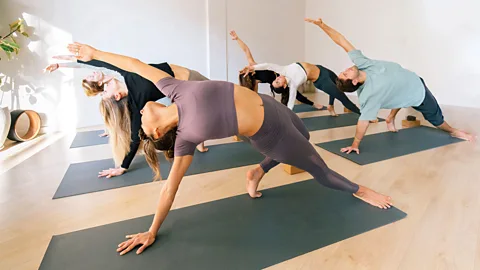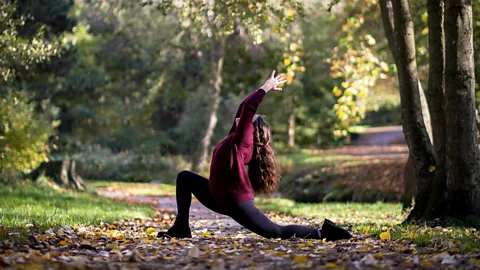The mind-altering power of yoga could improve your mental health
 Getty Images
Getty ImagesYoga has been found to increase grey matter and alter key networks in the brain. Now there are hopes it could be used to help improve people's mental health.
My right arm is shaking. Sweat drips from my forehead as I twist my body from a side plank into a yoga pose known as "Wild Thing" – or "Camatkarasana". It is quite the contortion – I arch my back, stretching my left arm over my head. My right foot is planted on the ground, and I look up to the sky.
One translation of the Sanskrit word camatkarasana is "the ecstatic unfolding of the enraptured heart" and is said to elicit confidence. And – despite the strain – I feel invincible.
When I started practicing yoga, I wanted to sweat and to build strength. I saw it purely as a form of exercise – but I found it was so much more.
The practice of yoga dates back over 2,000 years to ancient India. And though today, there are many different types of yoga – from meditative yin yoga to flowing vinyasa – through their use of movement, meditation and breathing exercises, all forms focus on a mind-body connection. And there is growing evidence that yoga may not just have physical benefits but may also be good for your mind too. Some researchers even hope it could be a promising way of helping people with post traumatic stress disorder (PTSD) cope with their symptoms.
Certainly, research on the physical benefits of yoga is extensive. The first thing anyone who hasn't tried yoga should know is that it can be surprisingly strenuous. It improves strength, flexibility and cardio-respiratory fitness. Studies have found yoga can improve stamina and agility. It can prevent injuries (although it can also be a cause of injuries if not done correctly) and enhance performance in other sports – with advocates including world-class footballers, American footballers and basketball players.
And there is a growing body of research showing yoga can be beneficial for a wide range of health issues.
In epilepsy sufferers, for example, practicing yoga has been seen to significantly reduce the number of seizures – or even prevent them entirely. Yoga has been used as an intervention to help manage type 2 diabetes, reduce chronic pain, and aid in stroke rehabilitation. It has also been shown to be more effective than physiotherapy at improving the quality of life for people with multiple sclerosis, and one trial even suggests it could be beneficial for cancer survivors.
 Getty Images
Getty ImagesYoga can also help you live a healthy life for longer, says Claudia Metzler-Baddeley, a cognitive neuroscientist at the Cardiff University Brain Research Imaging Centre (Cubric) in the UK.
But yoga has also been found to change the makeup of your brain. Studies show practicing yoga positively impacts both the structure and function of parts of the brain including the hippocampus, amygdala, prefrontal cortex, cingulate cortex and brain networks including the default mode network, part of the brain involved in introspection and self-directed thought. Some researchers say this could mean it has potential to mitigate age-related and neurodegenerative declinesfthere.
Metzler-Baddeley's research focuses on the cognitive and neural mechanisms of ageing and neurodegeneration. "We think inflammation accelerates ageing – which can be caused by chronic stress," she says. "Stress hormones like cortisol cause inflammation, which can cause increased blood pressure. These are, of course, risk factors for unhealthy ageing."
Meditation and mindfulness, she adds, are integral to yoga practice, and "seem to induce changes in brain networks which are important for metacognition, meta-awareness, and regulating emotional responses to stress".
"We know there's potential [for yoga to] keep us healthy as we age," she says. "There are studies that have found a number of structural differences [in the brains of people who practice yoga], and that certain areas important for metacognition and problem solving seem to be larger."
Neuroimaging has revealed yoga can lead to an increase in the volume of grey matter in the brain. Grey matter – or the cerebral cortex – is important for mental processes including language, memory, learning and decision-making. In Alzheimer's disease, there is a loss of grey matter volume and one 2023 study found yoga could slow memory loss among women at risk of the disease.
All exercise is known to boost your mood by lowering levels of stress hormones and increasing the production of endorphins – often referred to as the "feel-good chemicals". But the combined postures, breathing and meditative exercises in yoga may have additional benefits, reducing anxiety, stress, depression and improving overall mental health. Studies have shown that yoga can improve the short-term symptoms of depression, for example.
"I didn't want to go on. Life was too difficult," says Heather Mason, founder of yoga therapy training school The Minded Institute. "Yoga transformed my life – helping me manage depression, anxiety and PTSD."
 Alamy
AlamyAfter experiencing the profound effects of yoga, Mason went on to train in yoga, psychotherapy and neuroscience, before founding her yoga therapy training school in 2009. "I felt there were a lot of claims [about yoga] that were made that had no substantiated evidence. And when you have been hopeless for most of your life, you don't want to be peddled something that might work," she says.
Mason now trains health and yoga professionals in yoga therapy. "I realised that there was an accessibility problem," she says. "[Yoga] is marketed is for young, white, skinny women. If you don't see yourself reflected within this practice, you may not think it's for you."
It can be expensive, too, she adds, "This is why I am so dead set on its integration into the NHS [the UK's National Health System]." Plus, people with mental health issues can often struggle to engage in self-care, she explains. "They have to be motivated to do it. I thought, if we can bring it into the medical paradigm – all that will change."
Six Steps to Calm Newsletter
Discover a calmer future with this course of six science-backed techniques, delivered weekly to your inbox. Subscribe here.
Yoga has been found to increase levels of gamma-aminobutyric acid (Gaba) in the brain. This neurotransmitter slows down brain activity by blocking a nerve cells ability to receive and send chemical messages. Studies have found a 12 week course of yoga leads to increases in Gaba that were correlated to improvements in mood and decreases in anxiety.
"With meditation and deepening the breath, you switch from sympathetic to parasympathetic nervous activity. So, you're triggering the relaxation response," says Metzler-Baddeley.
When a person experiences a stressful event, their sympathetic nervous system – the part of the autonomic nervous system which controls involuntary body functions such as breathing and our heartbeat but also helps to govern our response – is triggered. Genes are activated to produce proteins called cytokines that cause inflammation at cellular level. In a dangerous situation, this allows the body to protect itself against wounding or infection. However, if someone experiences persistent stress, long-term inflammation can be damaging and increase the risk of cancer, accelerated aging and depression.
Researchers have found that people who practice mind-body interventions such as yoga and meditation experience a decrease in the production of cytokines – and so a reduction in the risk of inflammation-related diseases and conditions.
There are also some indications that yoga could be beneficial for some people suffering from PTSD. However, the results from other studies using yoga as an intervention for PTSD are mixed and there appears to be a shortage of high-quality research, according to one academic review. One recent study, however, showed that yoga could improve the outcomes of US veterans with PTSD while another showed frequent yoga practice could be beneficial for women with chronic PTSD.
"Treatment-resistant PTSD is a big problem," says Rachel Bilski, a yoga therapist and manager of the non-profit PTSD UK. "At the age of about 11, I was given a fistful of Prozac and cognitive behavioural therapy. Nothing worked. By my mid-teens, I was suicidal. I felt more broken because treatment wasn't working. It was like, if this is supposed to work and it isn't working, then there's something inherently wrong with me, and there's no way I'll ever be fixed."
 Pete Mainey
Pete MaineyFor years, Bilski suffered from panic attacks, nightmares and feelings of low self-worth. Until she discovered yoga.
On a "classic" post-university trip to Southeast Asia, she thought to herself: "Okay, let's try this yoga thing. It's probably for hippies." Every day, during savasana – at the end of the class when participants lie on the floor in relaxation – "I would cry and cry and cry," says Bilski. "I was crying from places that I didn't even understand. I was feeling different things. I was feeling safety in my body in a way that I didn't realise I needed. It was such a huge shift in one week."
Bilski cancelled all her plans for partying and instead, "went from yoga retreat to yoga retreat, and then ended up training, and then ended up going into yoga therapy".
Yoga therapy, she says, is distinct from other forms of yoga – not all types of yoga are good for PTSD sufferers, One recent review found evidence that types of yoga such as kundalini, satyananda, and hot yoga – which is practiced in a heated environment – could be most useful as an intervention.
In addition, most yoga teachers, says Bilski, are not equipped to deal with trauma. "You need a trauma-informed teacher. There are a lot of yoga teachers out there that could potentially provide classes that end up triggering people." If your body doesn't feel like a safe place to be, for example, but a yoga class brings a high level of awareness to your body, "then you can end up becoming triggered".
"Yoga therapists undergo a great deal more training [than regular yoga teachers]," says Bilski. "Yoga therapy is considered a healthcare profession, and is underpinned by biomedical understanding and psychotherapeutic training."
Yoga therapy, explains Bilski, is usually done on a one-to-one basis, tailored to the participant's specific needs, and focuses on "grounding skills" and breathing practices. "[By] tracking sensations in the body, we can decouple safety cues from danger cues. We use a posture as a vehicle for that kind of exploration, and self-regulation through breathing," says Bilski.
Yoga therapy, she says, can help PTSD sufferers to tolerate the physical or sensory experiences associated with their trauma. Giving people the means to control their symptoms in this way, say experts, indicates yoga has an "important role to play in the field of trauma recovery". Yoga is often used in tandem with other types of treatment. Just one of a list of complementary interventions – such as acupuncture, guided imagery and hypnotherapy – yoga can offer a second-line treatment option.
Metzler-Baddeley notes, however, that much of the research focuses on the mindfulness and breathing aspects of yoga – and not on holding poses, stretching or movement.
But, she adds, synchronising the poses with breathing is such an integral part of yoga. "You can't really tease them apart," she says. "It's tricky to know exactly what [is causing these changes in the brain]. Is it the stretching? Or is it the breathing? Or the relaxation. I don't know whether it necessarily matters if the whole package works."
It is an area that will require more research to unravel fully. But in the meantime, with both feet planted firmly on the ground, my line of sight on my middle finger, my arms outstretched in Virabhadrasana 2 pose – or Warrior 2 – I feel calm and strong, and present in the moment.
"Yoga can shift the whole mind-body complex." says Mason. "It's a long road but it has that power. I think that's probably why it's been practiced for thousands of years."
--
For trusted insights into better health and wellbeing rooted in science, sign up to the Health Fix newsletter, while The Essential List delivers a handpicked selection of features and insights.
